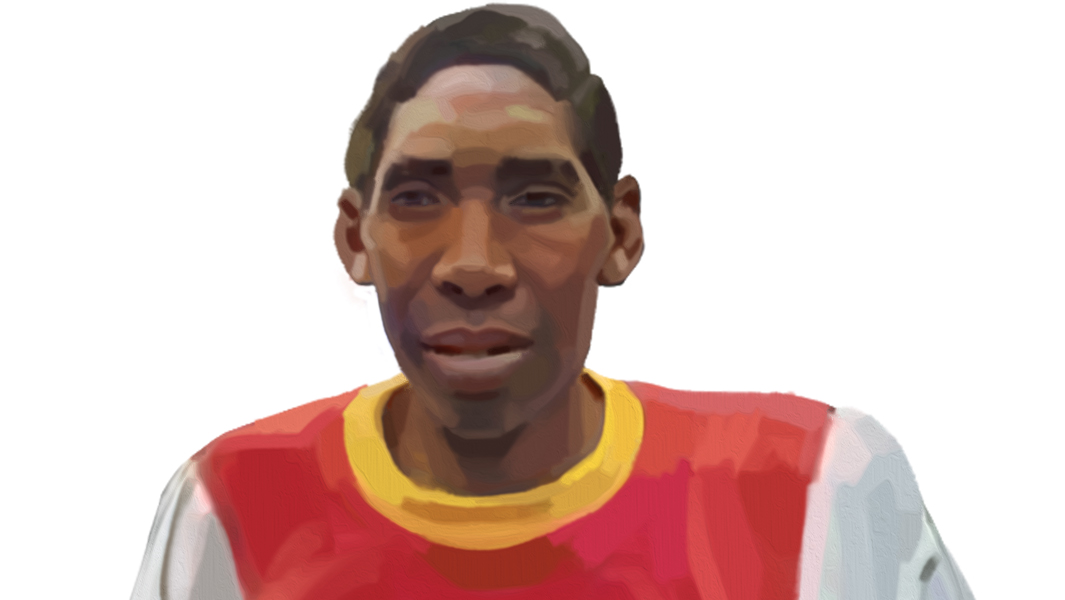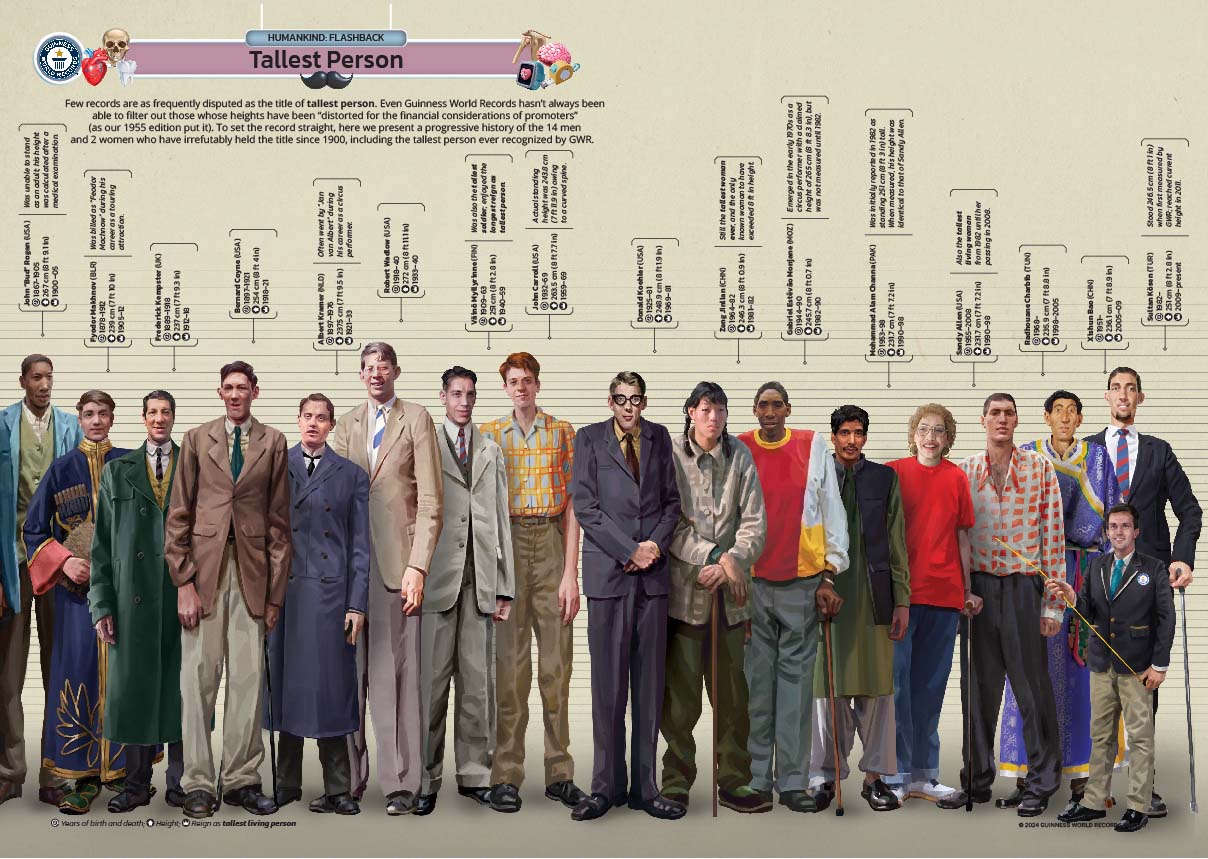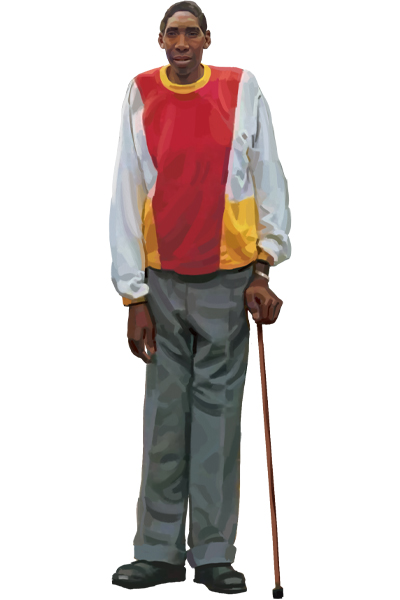Gabriel Monjane: A history of the world's tallest people

With the deaths of Don Koehler and Zeng Jinlian, the title of tallest person passed to Gabriel Monjane, a former circus performer who was then running a restaurant in Maputo, Mozambique. When he was finally measured, Gabriel was an impressive 8 ft 0.75 in (245.7 cm), and was probably a few centimetres taller in his youth.

Early life and health
Gabriel Estêvão Monjane was born in 1944 (his exact birth date is unknown) in the town of Manjacaze (also sometimes written as Mandlakazi), which is located in southern Mozambique, around 250 km north east of the capital, Maputo.
At time of his birth – and for most of Gabriel’s youth – Mozambique was part of the Portuguese Empire, a colony that was by then euphemistically referred to as an "overseas province of Portugal". Under this system, Manjacaze was a minor administrative centre and the capital, then known as Lourenço Marques, was the seat of Portuguese political and military power.
It seems that Gabriel's childhood development was more or less normal, but his growth apparently began to rapidly accelerate after the age of 10. According to some accounts, this sudden growth spurt followed a fall from the upper floor of a building, which caused a severe head injury. It is possible that this injury could have damaged his pituitary gland and caused his gigantism, but it may also have simply been a coincidence. Whatever the cause, by the age of 12 Gabriel was 190 cm tall (6 ft 2 in) and this had risen to 228 cm (7 ft 6 in) by the time he was 16.
As a native Mozambican, Gabriel would have had access to only a very limited education at an "Adaptation School" run by Catholic missionaries. Mozambican children were typically given just three years of general instruction – mostly in Portuguese – and then would have had to write an application and take a test to enter a government-run primary school. The odds of making this jump were low, however.
In 1954, 180,000 children completed their mission-school education in Mozambique and only 2,500 made the transfer to primary school. Like around 98% of the native Mozambican population at the time, Monjane was likely functionally illiterate, at least in his youth.
Discovery and early fame
By the early 1960s, the giant teenager had become something of a local celebrity, but his day-to-day life remained unchanged. He worked at a factory that shelled and packed cashew nuts for export and lived with his mother.
This changed in December 1965, when reporters from newspapers in Maputo came to look into the stories of the "Manjacaze Giant". They took a photo of Gabriel – by then 21 years old and around 238 cm tall (7 ft 10 in) – walking with his normal-sized mother in the street. This image was picked up by wire agencies and reprinted in newspapers around the world.

An illustration of Gabriel
The first group to get hold of him after the initial reports were the medical authorities in the colonial capital. He was brought to Lourenço Marques Central Hospital where he was "examined by anthropologists and medical authorities" (according to contemporary reports). The doctors described him as a good humoured and pleasant young man, but don't seem to have made any attempt to treat the underlying medical issues that might have caused his growth.
After the publicity surrounding his "discovery", Monjane often made public appearances in Lourenço Marques. He was frequently exhibited at festivals and fairs organized for the white Portuguese settler community, often simply placed in a tent with a basket in front of him for tips.
It's not clear to what extent he made these appearances willingly as the colonial administration oversaw a practice known as contrato ("contract"), which allowed native Mozambicans to be press-ganged into months-long stints of work at Portuguese-owned businesses or government projects, with legal punishments for those who refused.
Born in Manjacaze, Gaza Province, Mozambique, Gabriel Estêvão Monjane is one of only twenty individuals in medical history to have reached eight feet or more in height. The Guinness Book of World Records stated that he was the tallest living man in their 1988 edition. pic.twitter.com/DQWhmimpjR
— African History & Culture | Talkafricana.com (@talkafricana) October 2, 2022
There are a few reports of Gabriel receiving offers of work overseas during this time. He was apparently approached by the British circus ringmaster Richard Chipperfield in 1966, and newspaper reports from 1967 mention that he had signed up for a world tour with the Spanish magician "Professor Max" (real name Juan Elegido Millán). For some unknown reason, neither of these offers seem to have come to fruition.
Leaving for Europe
It was not until 1969 that Gabriel left Mozambique, headed for Portuguese capital of Lisbon. A farewell party was held in his honour at the Cinema Manuel Rodriguez, which was then one of the largest venues in Lourenço Marques.
For the next five years Gabriel lived in Portugal, only occasionally travelling further afield on tour. He was employed by a circus promoter who often paired him with a 75-cm-tall Angolan man known only as "Lucio the Dwarf".
In August 1970, the pair made an unexpected appearance at the state funeral of the ultra-conservative Portuguese dictator Antonio Salazar (who had ruled the country and its overseas possessions since 1932). Their presence in the midst of the country's most powerful politicians was described by foreign journalists as a spectacle reminiscent of Diego Velázquez's 17th century portraits of the Spanish royal court.
Salazar – 29 de julho de 1970 - velório , abrilhantado por Gabriel Monjane, o Gigante de Manjacaze, um negro moçambicano cuja desregulação hormonal o fizera crescer até aos 2,45 metros, com os horríveis padecimentos do gigantismo, e o anão de Arcozelo, https://t.co/o6xyev4vie pic.twitter.com/1Ob89rsl0m
— Hermínio Cerqueira (@HerminioCerq) November 21, 2022
Accounts from this time say that Gabriel seemed depressed and withdrawn. He apparently resented being publicly exhibited and felt he was being financially exploited by managers and promoters.
In 1970, he tripped and fell on a staircase at a venue in Lisbon, breaking his hip. When it failed to heal properly, doctors attempted surgery, but not only did they not resolve the problem, they also left him with one leg around an inch shorter than the other.
His bookings declined after the public's initial interest passed, and he settled for a time in Lisbon in the early 1970s. He married a Portuguese woman, Inacia Monjane, and started a family.
The only one of his three children whose name seems to have been recorded anywhere is his youngest son, Eduardo (born in 1978), who may have been named after the Mozambican independence activist Eduardo Mondlane (whose surname was an alternate spelling of Gabriel’s, and who was from the same town).
It is very unusual for a giant to be able to have children, the only other examples of men who held the title of tallest person and who were also fathers are Fyodor Makhnov (who had five children) and Albert Kramer (who had one child that died in infancy).
It is around this time that Gabriel’s growth seems to have finally stopped at around 246 cm (8 ft 1 in). His standing height was slightly lower on account of his hip injury.
Later life
In 1974 the autocratic "Estado Novo" regime was overthrown in Portugal, and the country relinquished its claims to its former colonies, including Mozambique. Monjane and his family moved back to his newly-independent homeland, where he and his wife set up a restaurant called Alfacinha (a colloquial term for someone from Lisbon) in Maputo. By this time he was experiencing severe mobility issues, though he remained a common sight at the restaurant, where he talked to customers and posed for photos.
Gabriel was again thrust into the international spotlight in 1982. The death of Don Koehler in 1981 and Zeng Jinlian the following year meant that Gabriel was now officially the tallest person in the world and promoters began to seek him out again.
His new status meant that he could be more selective with his public appearances, getting good pay and first-class travel when he visited other countries. By 1986, he and his wife could afford to move back to Lisbon with their youngest son, Eduardo, who was eight years old.
Gabriel Monjane is a Mozambican man who was eight feet tall (2m45) and the tallest man in the world at the end of the 80s. He is one of the only twenty individuals in medical history to have reached eight feet or more in height.
— 𝐀𝐅𝐑𝐈𝐊𝐀 (@MyFrika) May 29, 2021
In 1969, he was brought to... pic.twitter.com/ObHdTFpnvI
Gabriel Monjane on a Japanese TV show with the then-heaviest-man Albert Pernitsch in 1986
One of the most important benefits of this second wave of fame came in 1987, when a group of South African businessmen paid for Gabriel to have hip surgery at the Sandton Clinic in Johannesburg. His benefactors owned the national franchise for the Makro supermarket chain, which Gabriel had done promotional work for in the past. Thanks to this treatment, he was able to walk without pain for the first time in years.
The newly mobile Gabriel made a series of promotional appearances for Makro in South Africa, Mozambique and even Thailand in the late 1980s. He also appeared on Guinness World Records TV shows in several countries.
In his final years, Gabriel appears to have split his time between Mozambique and Portugal, though his size and declining health made travelling difficult. He died in a hospital in Maputo on 21 January 1990, following a fall at his home in Manjacaze. He was 45 years old.


